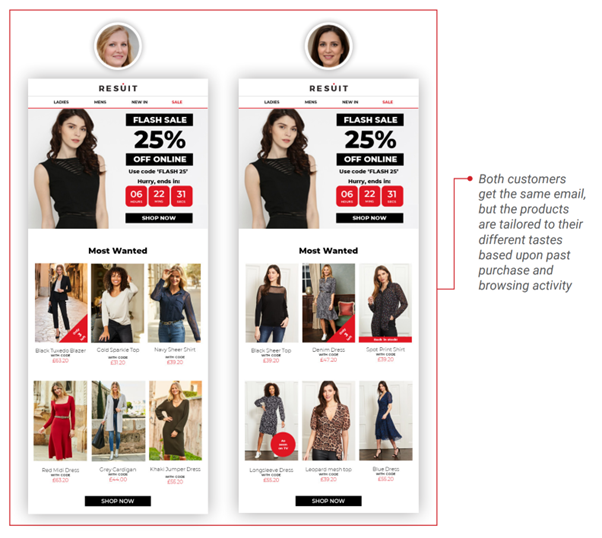What do we mean by personalisation in email marketing?
According to Bluecore, 57% of brands number one email priority is email personalisation, which is unsurprising considering personalised emails can generate 6-times the transaction rates compared to ‘batch and blast’ (Source: Experian).
With the demand for personalisation from email marketers being so high, it’s inevitable that every technological solution under the sun claims to be a personalisation solution when, in reality, it’s anything but.
Personalisation is complex, time consuming and usually requires some input from other teams in the business. With email marketers as stretched as ever it’s important not to waste time disappearing down the wrong personalisation approach. With the myriad of options available to marketers in this area it’s useful to know what those options are, and what the relative advantages and disadvantages of each are.
This article tries to address what personalisation is and offer an overview of the relative merits of different approaches.
What is personalisation?
So, we all know that ‘Hi {{firstname}}’ isn’t a type of personalisation that is especially meaningful.
Our personal take on what true personalisation really is, is that it’s about content that is tailored to each individual’s tastes and preferences. It is here that the performance of personalisation with content being truly unique to each recipient that performance uplifts are seen at scale. The following is an example of an email that takes that individualised approach:

Equally personalisation can be much simpler. Perhaps grouping customers into similar buckets, whether that be sending several emails instead of one, or tailoring sections of one email according to these buckets of customers.
Each approach to personalisation can be thought of as a step on the ladder. Each rung of the ladder gives you greater potential for increased performance but requires more effort to get there.

Let’s go through each of these steps and discuss the pros and cons of each approach.
Segmentation
Strictly speaking, this isn’t personalisation but we include it here because so many refer to this as such. Segmentation, in the context of email, is sending different emails to different groups of customers based upon a series of rules.
This could be a brand-specific promotion to those that previously bought the brand. The obvious problem with this approach is that it requires a lot of manual creation of email content; something that most email teams don’t have the resource for.
Revenue per email will be much higher than ‘batch and blast’ but it’s much harder to reach the same volumes of emails sent to realise this increase. The other area we might see segmented campaigns is triggered messaging, such as abandon baskets or welcome emails.
These are, in reality, a segmented email with the criteria simply being ‘abandoned shopping cart today.’
Pros
- Easy & quick to get started
- Ideal for test cases proving personalisation delivers additional revenue
Cons
- Requires significant additional production resources
- Content still tends to be fairly generic rather than personalised to each individual’s taste
Dynamic Content
A step up from segmentation is dynamic content. This is where a single email is sent to the whole audience, but one or multiple sections of the message are varied based upon rules.
If we take the brand promotion further, you might have a rule for those whose last purchase was Adidas, another for Nike, and so on.
While an improvement from segmentation, it still lacks scalability as you are limited by the amount of time you have to both create the content for each variation, and the number of rules you can write.
Pros
- Potential for more personalised combinations than segmentation
- Easy to keep evolving and adding to
Cons
- Personalisation is limited to the number of rules and associated content you have time to produce
- Can require advanced coding skills to implement in many email marketing systems
- Often isn’t re-usable if you need to manually change the content for the next campaign
Content Personalisation Algorithms
In a small number of email platforms, there is an option to create your own basic algorithms for pulling content in. Rather than writing a rule for each variation, these will pull content based upon data in a customer field.
For example, if we again use the brand example, the algorithm will fetch products that match the customer’s ‘last brand purchased’ field in the platform. This means you can cater for many more variants and not have to manually build each variant. You can do a one-time setup and use it for any campaigns going forward without extra effort.
However, these options tend to prevent marketers from having granular control over what is shown. You might be able to display the products in order of popularity, but very little control after that. This includes the problem of showing the same products in every personalised email you send, so the list of products quickly becomes stale and less effective.
There is also the issue of what data is available for the algorithm to generate results. You might know the brand a customer purchased previously, but they may have only ever purchased it once. Therefore, they can only be used to recommend more of the same than assist with breadth.
Of course, different platforms have varied levels of control and flexibility, something to take into account when evaluating the practical implications of this functionality.
Pros
- Can generate content per individual for less effort than manual personalisation rules
- Set-up once, low ongoing maintenance required
Cons
- Often lack granular merchandising control over the results shown or repeat the same items each time
- Only uses known or past behaviour to personalise, leading to a cycle or recommending more of what they have just bought
Artificial Intelligence (AI) Product Recommendations
With the content algorithms, we discussed a weakness that they only return items based upon known past purchases, preferences, or behaviour.
AI Recommendations try to overcome this by using the past purchase data to find similar customers who also bought the same items and then look at what those individuals also bought. It’s the same principle you see on Amazon with ‘customers who bought this product also bought these items.’
These recommendation systems promise a lot. For little effort beyond dropping a few tags into your template, they enable you to add fresh product content that is tailored to your customer’s specific tastes.
Unfortunately, it’s not always that simple as not all solutions are created equal.
The quality of the results delivered by any AI is down to two factors:
- The quality of the algorithm
- The quality and breadth of the data used
Many of these recommendation products are generic black-box algorithms, where the nature of how the algorithm works is hidden in mystery. The exact same algorithm and data inputs are expected to work equally well for every type of business - from luxury fashion retailers to online travel agencies and discount stores. It is absurd to suggest this can work optimally for every business.
The lack of control over results can create practical issues, too. Will the recommendations show the same products in every email the customer opens? How do you stop the results from being filled with one type of product? Can you control what gets shown with merchandising rules? There is no point in sending a sale email with products recommended that aren’t in the sale.
Then there are those AI Recommendations that aren’t really personalisation solutions at all, but offer flavours like ‘best sellers’ or ‘new products’ - they are simply generic lists of products that everyone will see.
You might at this point be thinking why is this at the top of the email personalisation ladder if there are so many issues? We have highlighted the potential pitfalls because there is such a range of hyped solutions being offered to email marketers in this area that it’s vital to separate the good from not-so-good.
The better solutions give the marketer greater control over the nature of the algorithm and the results are shown to provide the ultimate level of personalisation (all while saving them significant email production time).
Pros
- The greatest potential for matching product content to customer tastes with the greatest potential for revenue uplifts
- Can assist with promoting a breadth of relevant items, even when a customer has purchased only one or two items previously
Cons
- Buyer beware: AI solutions are only as good as the algorithm and the data that is used in the algorithm
- Solutions often lack the granular level of control to use at scale across a range of email campaigns
A note on real-time email content solutions
Growing in popularity are real-time email content solutions. These work by inserting image tags in the email that adapt the moment they are opened. This allows the content to be personalised based upon contextual factors such as the current time, weather in the location, or the customer’s proximity to their nearest store.
Critics would argue that without additional data and logic to make decisions on the right content for each individual, their value is limited.
However, these play a welcome part in email personalisation and can have other benefits. One such way includes having a simplified and agile approach to integrating personalised content into the email without having to worry about the restrictions of the email-sending platform’s personalisation suite.
Some of the more innovative creative emails over the last few years have been developed with real-time email content platforms due to the ability to produce personalised images with no restrictions on styles or fonts like traditional HTML emails suffer from
Summing up
Sometimes it can be observed that personalisation is treated as a tick-box exercise. But not all personalisation and approaches are equal. That is why its important to evaluate the options open and decide if they really are realistic for the resources available to you and your desired revenue outcomes.
 Photo by Brett Jordan on Unsplash
Photo by Brett Jordan on Unsplash

 How to resolve AdBlock issue?
How to resolve AdBlock issue? 
 Sean Duffy is founder of Segmentum, an eCRM strategy & implementation agency, and Reignite, a real-time email personalisation platform.
Sean Duffy is founder of Segmentum, an eCRM strategy & implementation agency, and Reignite, a real-time email personalisation platform.